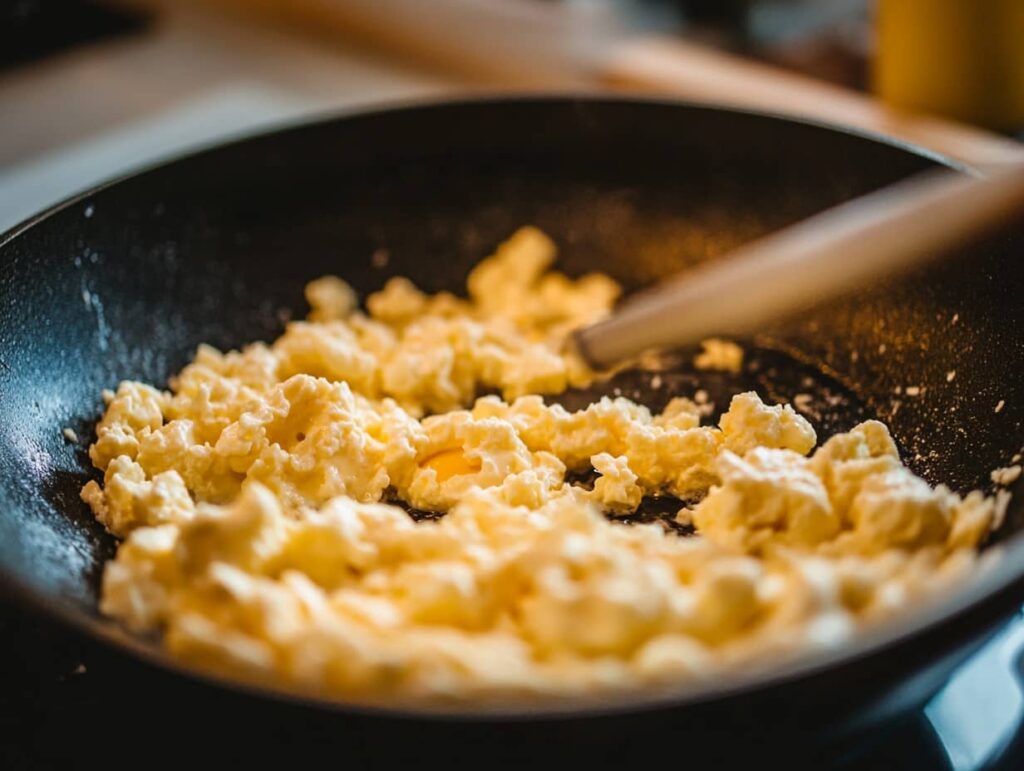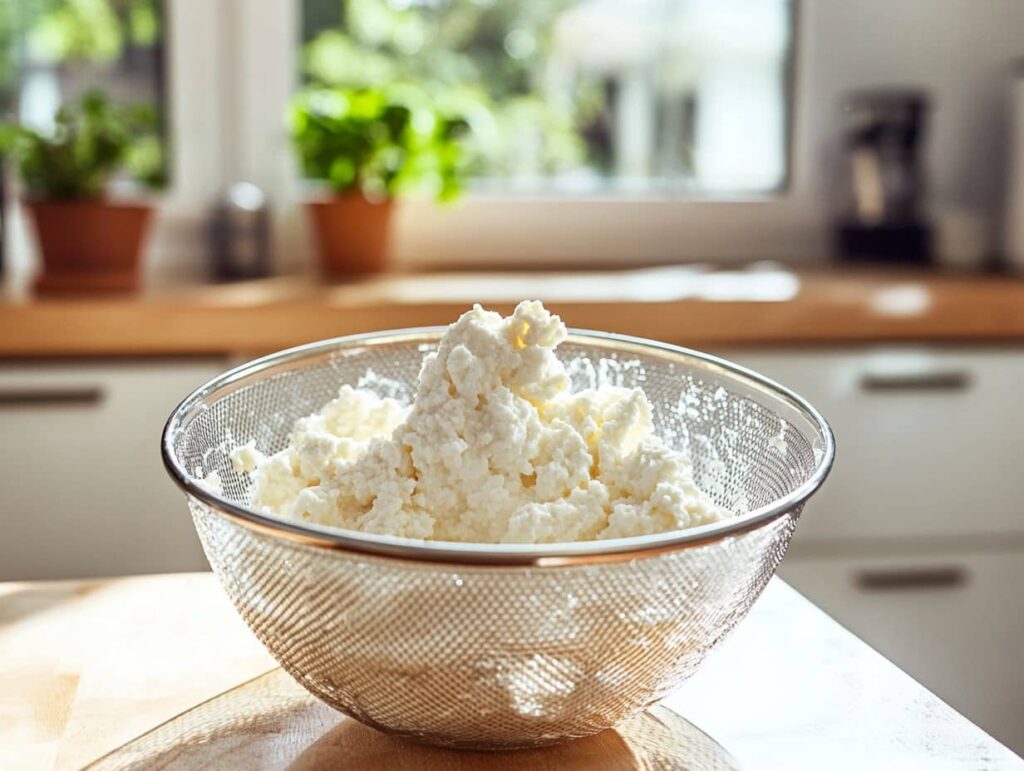What Are Cottage Cheese Eggs?
Cottage cheese eggs might sound like an unusual pair, but they’re actually a match made in culinary heaven. Essentially, this dish involves blending fluffy scrambled eggs with creamy cottage cheese. The result? A protein-packed, soft, and creamy delight that’s as versatile as it is delicious.
But hey, they’re not just about taste. This combo packs a punch nutritionally.If you’re new to this dish, check out our guide to fluffy cottage cheese scrambled eggs for inspiration.
Nutritional Benefits of Cottage Cheese Eggs
Why go for plain scrambled eggs when you can power them up with cottage cheese? Adding cottage cheese gives your eggs a protein boost, helps build muscles, and keeps you full for longer. Plus, it’s loaded with calcium, which your bones will thank you for.Read more about how to make cottage cheese taste amazing with eggs.
Oh, and here’s a little secret: the creamy texture means you can skip the heavy cream or milk, making it a healthier alternative!
Why Cottage Cheese and Eggs Make a Perfect Pair
Cottage cheese and eggs complement each other, like peanut butter and jelly. The smooth creaminess of the cheese balances the fluffiness of the eggs. They’re also quick to prepare, making them perfect for breakfast, lunch, or even dinner.
But if they’re so perfect together, why do they sometimes turn watery? Let’s break it down.
Common Reasons for Watery Cottage Cheese Eggs
Improper Cooking Techniques
Eggs and cheese need a little finesse to cook properly. Using high heat can make the eggs cook too fast, causing them to release water. Scrambling too quickly or cooking in an overheated pan also leads to a watery texture.
Think of it like playing an instrument you need patience and precision. Cook your cottage cheese eggs on medium to low heat and stir gently to keep everything in harmony. Slow, steady cooking is the key to avoiding a soggy result!
Using Too Much Cottage Cheese
Adding extra cottage cheese might seem like a great way to boost flavor, but it can backfire. Cottage cheese naturally contains a lot of water, and using too much can overwhelm the eggs, leaving you with a runny, watery mess.
To keep things creamy and balanced, stick to about one tablespoon of cottage cheese per egg. This ratio ensures you get the flavor and texture you want without overloading the dish with excess moisture. Pro Tip: Less is more when it comes to cottage cheese!
Excess Moisture in Ingredients
Cottage cheese, especially low-fat varieties, holds a lot of water. This moisture often separates when heated, making your eggs watery. Adding veggies like tomatoes or mushrooms can worsen the problem since they release liquid as they cook.
To avoid this, always drain your cottage cheese using a fine mesh strainer or pat it dry. If using vegetables, cook them separately first to reduce their moisture. Also, keep your pan uncovered while cooking to let steam escape naturally. These simple tweaks can prevent watery eggs and ensure perfect consistency!
Low-Quality Cottage Cheese Brands
Not all cottage cheese is the same, and the quality can make or break your dish. Some brands contain more water or have a grainy, less creamy texture. These inconsistencies can result in watery cottage cheese eggs, even if you follow the recipe perfectly.
To avoid this, choose a brand known for its thick and smooth cottage cheese. Look for options labeled as “small curd” or “low-moisture” for better results. Always check the expiration date too fresh cottage cheese not only tastes better but also holds its structure more effectively when cooked.
How to Fix Watery Cottage Cheese Eggs
Adjusting Cooking Times and Heat Levels

Cooking eggs is all about finding the right balance. Think of it like slow dancing you need a steady rhythm. Use medium to low heat to cook your cottage cheese eggs gently. This allows the ingredients to blend and set evenly without releasing excess water.
Stir occasionally but not too aggressively, as overmixing can break the eggs apart and make them watery. Avoid cranking up the heat to speed things up high heat causes the eggs to cook unevenly and release moisture, leaving you with a soggy mess. Slow and steady wins the race for perfectly creamy eggs! Balance is key! Explore ingredient options for the perfect egg recipe in our article on cottage cheese eggs.
Draining Excess Moisture from Cottage Cheese
Draining cottage cheese is a game-changer for fixing watery cottage cheese eggs. Simply place the cottage cheese in a fine mesh strainer and let it sit for a few minutes to release the excess liquid. For extra effectiveness, press gently with a spoon or pat it dry with a clean kitchen towel.
This quick step is essential for removing unnecessary moisture, ensuring your eggs stay creamy and firm instead of turning into a watery disappointment.
Choosing High-Quality Ingredients
Invest in good-quality cottage cheese. Look for brands with a thicker texture and less water. Organic options often have better consistency, too.
Quote to Remember: “Good ingredients make good food. Don’t skimp on the basics.”
Balancing Ingredient Ratios
The key to perfect cottage cheese eggs is keeping the ratio just right. Use about one tablespoon of cottage cheese per egg for a balanced, creamy texture. Adding too much cheese can overwhelm the eggs and make them watery.
If you’re including extras like veggies or herbs, sauté them first to reduce moisture. This step ensures they complement the eggs without adding unwanted liquid, keeping your dish flavorful and consistent.
Step-by-Step Guide to Making Perfect Cottage Cheese Eggs
Let’s get practical! Here’s how you can whip up cottage cheese eggs that are creamy, flavorful, and far from watery. Follow this guide, and you’ll be the master of the skillet in no time.
Ingredients You’ll Need
Before you begin, gather everything you need. Here’s your shopping list:
- Eggs (2-3 per serving)
- Cottage cheese (1 tablespoon per egg; go for full-fat for creamier results)
- Butter or olive oil (just a dab for the pan)
- Optional add-ins: diced veggies, shredded cheese, or fresh herbs like parsley
Keep it simple. Fewer ingredients often mean better control over the final dish.
Preparing the Cottage Cheese

This is a crucial step. Cottage cheese often comes with excess liquid, so don’t skip the draining process. Here’s how you do it:
- Scoop the required amount of cottage cheese into a fine mesh strainer.
- Let it sit for 5-10 minutes to drain off the excess moisture.
- Use a spoon to gently press the cheese for extra drainage.
Chef’s Tip: If you’re in a rush, pat the cottage cheese dry with a clean kitchen towel.
Cooking Tips for Perfect Consistency
Here’s where the magic happens!
- Warm the Pan: Start with medium-low heat. Add a small amount of butter or olive oil and let it melt evenly across the pan.
- Beat the Eggs: Crack your eggs into a bowl and whisk them until smooth. This incorporates air and gives you fluffy eggs.
- Combine with Cottage Cheese: Fold the drained cottage cheese into your beaten eggs. Don’t overmix just a few gentle folds will do.
- Cook Slowly: Pour the mixture into your pan. Stir gently with a spatula, scraping the sides and bottom of the pan.
- Watch the Texture: Once the eggs are mostly set but still a little shiny, remove them from the heat. They’ll finish cooking with residual warmth.
Quote to Remember: “Patience is key good food doesn’t rush.”
Avoiding Common Mistakes in the Future
Mistakes happen, but the good news is they’re totally fixable. Let’s go over a few missteps and how to avoid them next time.
Cooking Do’s and Don’ts for Cottage Cheese Eggs
Do:
- Use fresh ingredients for the best taste and texture.
- Cook on medium to low heat to avoid overcooking.
- Experiment with flavors but stay mindful of ingredient ratios.
Don’t:
- Overload the pan with cottage cheese. Less is more!
- Skip draining the cottage cheese. That’s a fast track to watery eggs.
- Add raw veggies without cooking them down first.
Storing and Reheating Tips
If you’ve got leftovers (lucky you!), here’s how to keep them delicious:
- Storing: Place the eggs in an airtight container and refrigerate for up to 2 days.
- Reheating: Use low heat on the stove or a microwave at 50% power to avoid drying them out.
Emoji Alert: 🥶 Store smart, reheat gently no one likes rubbery eggs!
Healthier Alternatives and Variations
Cottage cheese eggs are a fantastic canvas for creativity. Here are some ways to tweak the recipe to suit your taste or dietary needs.
Low-Fat Cottage Cheese Options
Want to cut down on fat without sacrificing flavor? Opt for low-fat or fat-free cottage cheese. Just remember to drain it extra thoroughly since these varieties tend to hold more water.
Adding Vegetables for Extra Flavor
Brighten up your dish by tossing in some veggies. Here are a few ideas:
- Spinach: Adds a pop of green and loads of nutrients.
- Bell Peppers: Sweet and crunchy, they pair perfectly with eggs.
- Mushrooms: Sautéed mushrooms bring an earthy, umami flavor.
Cook your veggies separately before mixing them with your eggs to keep things crisp, not soggy.
Check out these delicious ideas for pairing eggs and cheese to inspire your next meal.
Expert FAQs About Cottage Cheese Eggs
Still scratching your head over watery cottage cheese eggs? Don’t worry you’re not alone! Let’s address some of the most frequently asked questions to ensure your eggs turn out perfect every time.
How Can I Make Cottage Cheese Eggs Less Watery?
The secret lies in preparation. Always drain the cottage cheese before mixing it with eggs. Use a fine mesh strainer or pat it dry with a clean towel. Adjust your cooking temperature to medium-low and avoid overloading your eggs with wet ingredients like raw veggies. Read our full breakdown on fixing watery cottage cheese eggs.
Quick Fix: If your eggs are already watery, cook them for a little longer on low heat to evaporate the excess liquid.
What’s the Best Cottage Cheese for Cooking?
Full-fat cottage cheese works best for cooking. It has a creamier texture and less water than low-fat or fat-free versions. If you’re aiming for extra flavor, some brands even offer herbed or seasoned varieties. Learn more about the differences between brands in our detailed guide.
Can I Use Cottage Cheese Substitutes?
Absolutely! If you don’t have cottage cheese on hand or prefer something different, try these substitutes:
- Ricotta cheese: Similar texture but slightly sweeter.
- Greek yogurt: Tangy and creamy, but make sure to use a thick variety.
- Mascarpone: Luxuriously creamy, but use sparingly since it’s richer.
Emoji Tip: 🌟 Experimenting with substitutes can give your dish a whole new personality!
Is There a Trick to Perfect Consistency?
Yes, it’s all about control. Drain the cheese, use the right ratio of eggs to cottage cheese, and cook low and slow. Stir gently to keep the texture creamy rather than overcooked.
Conclusion: Mastering the Art of Cottage Cheese Eggs
So, why are your cottage cheese eggs so watery? The answer lies in mastering fixing watery cottage cheese eggs with the right preparation and technique. By understanding the unique nature of cottage cheese and how it interacts with eggs, you can troubleshoot the problem and enjoy a perfectly creamy, satisfying dish every time.
Cooking is as much about experimenting as it is about following rules. With these tips and tricks for fixing watery cottage cheese eggs, you’re equipped to make a dish that’s not just delicious but also Instagram-worthy. So, grab your whisk, test these methods, and let your kitchen adventures begin!

